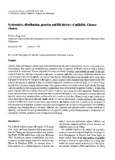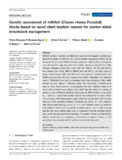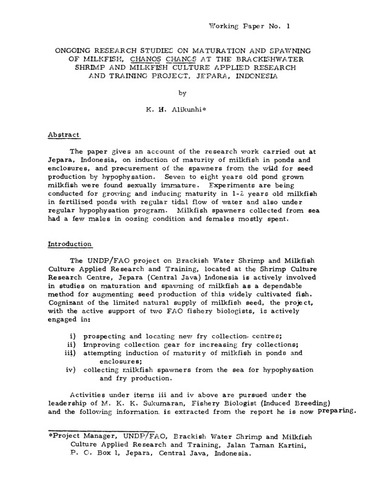Microbial diversity assessment in milkfish culture ponds
Share
| dc.contributor.author | Dalmacio, Leslie Michelle | |
| dc.contributor.author | Ramirez, Bernadette L. | |
| dc.contributor.author | Estacio, Rhodora | |
| dc.contributor.author | Borlongan, Ilda G. | |
| dc.contributor.author | Ramirez, J. M. | |
| dc.contributor.author | Evangelista, Karen V. | |
| dc.contributor.author | Madlangbayan, E. | |
| dc.contributor.author | Guillergan, Fred | |
| dc.contributor.author | Kron, M. A. | |
| dc.coverage.spatial | Tigbauan | en |
| dc.coverage.spatial | Iloilo | en |
| dc.coverage.spatial | Philippines | en |
| dc.date.accessioned | 2024-03-11T04:02:57Z | |
| dc.date.available | 2024-03-11T04:02:57Z | |
| dc.date.issued | 2020-02 | |
| dc.identifier.issn | 2582-3760 | |
| dc.identifier.uri | http://hdl.handle.net/10862/6521 | |
| dc.description.abstract | Aims: To determine bacterial diversity in milkfish culture ponds that contain different life-cycle stages of the milkfish (pond A: fry, pond B: juveniles and pond C: adults) by DNA sequence analysis of organisms and compare that microbial diversity to organisms found in soil adjacent to the ponds. Study Design: Comparative metagenomic study of aquatic and terrestrial biodiversity based on DNA sequence analysis of water and soil DNA. Place and Duration of Study: SEADEC milkfish ponds in Tigbauan, Iloilo, Philippines. All water and soil samples were collected over a three-day period. Methodology: DNA sequence analysis of nucleic acids extracted from water samples collected from the three types of milkfish ponds along with soil adjacent to the ponds. DNA was extracted and PCR was performed using the 11F-1492R primer pair to amplify 16S rRNA gene. Purified 16S rDNA amplicons were cloned in using the TOPO-TA cloning kit for DNA sequencing. 16s rRNA gene sequences were analyzed with the use of software tools at the National Center for Biotechnology Information website and imported into the ARB phylogenetic analysis software. Distance matrices were exported using the neighbor-joining algorithm in ARB, in the form of PHYLIP-formatted lower triangular matrices. The distance matrices were then used to calculate Shannon-Weaver and Simpson diversity indices to evaluate the richness and evenness of the sampled populations. Rarefaction curves were determined to evaluate sampling efficiency. Results: Rarefaction curves indicated that the sampling effort was sufficient to reveal the majority of phyla present in the sample. Shannon-Weaver and Simpson indices suggested that the diversities of all the groups were statistically different from each other. It was observed that pond A was least diverse, followed by pond C and pond B. The soil was most diverse. DNA sequence analysis identified the various species of bacteria in soil and water. Conclusion: All three pond communities were significantly different in diversity. This study did not identify any significant human pathogens such as Vibrios, Salmonella or Shigella. Bacterial diversity of sites decreased in the following order: soil > fry pond > fingerling pond > adult pond. | en |
| dc.language.iso | en | en |
| dc.publisher | Sciencedomain International | en |
| dc.relation.uri | https://journalajfar.com/index.php/AJFAR/article/view/89/177 | en |
| dc.subject | milkfish | en |
| dc.subject | microbial diversity | en |
| dc.title | Microbial diversity assessment in milkfish culture ponds | en |
| dc.type | Article | en |
| dc.citation.volume | 5 | en |
| dc.citation.issue | 3 | en |
| dc.citation.spage | 1 | en |
| dc.citation.epage | 12 | en |
| dc.citation.journalTitle | Asian Journal of Fisheries and Aquatic Research | en |
| dc.subject.asfa | milkfish culture | en |
| dc.subject.asfa | pond culture | en |
| dc.subject.asfa | DNA sequences | en |
| dc.identifier.doi | 10.9734/ajfar/2019/v5i330077 | |
| dc.subject.scientificName | Chanos chanos | en |
| local.subject | Milkfish | en |
| local.subject | bangus | en |
| local.subject | Chanos chanos | en |
| local.subject | aquaculture | en |
| local.subject | microbial diversity | en |
Files in this item
| Files | Size | Format | View |
|---|
This item appears in the following Collection(s)
-
AQD Journal Articles [1215]
These papers were contributed by AQD staff to various national and international journals



